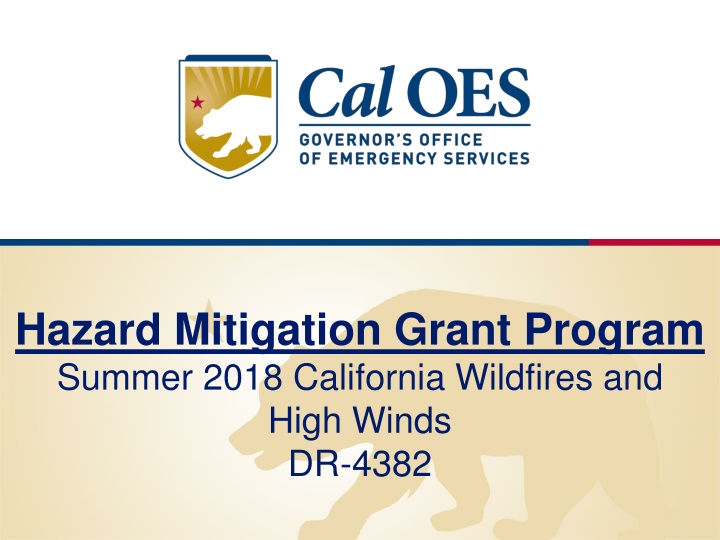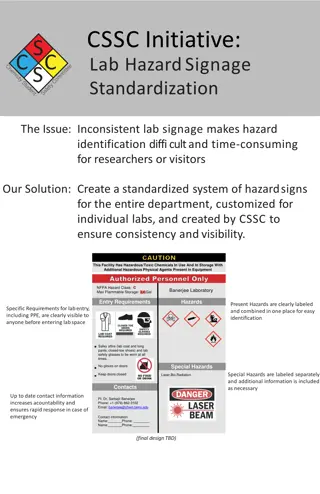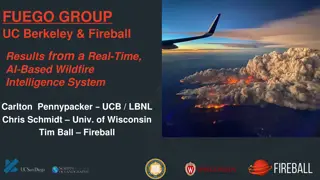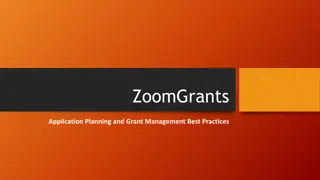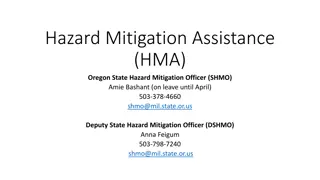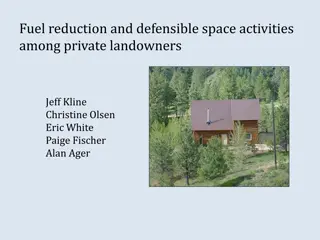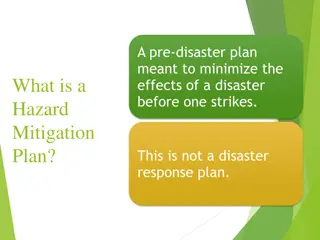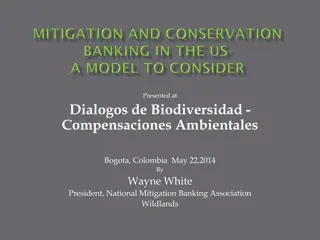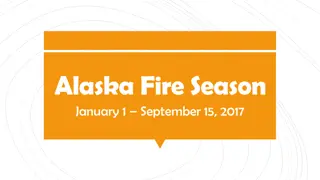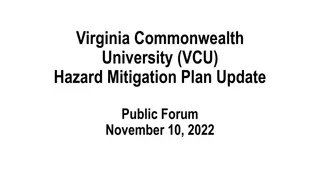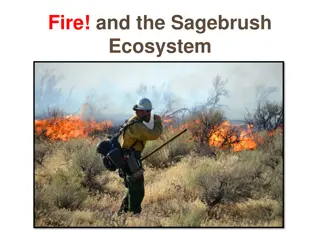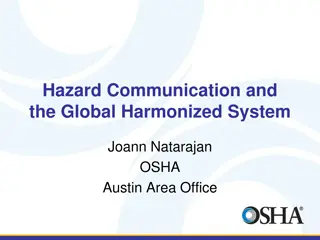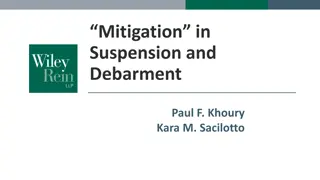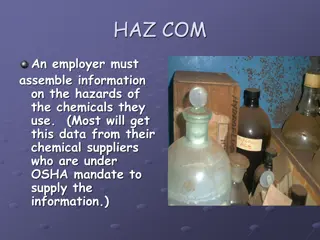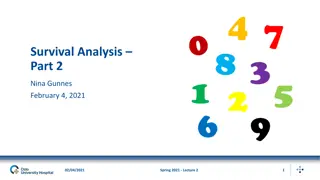Mitigating California Wildfires: Hazard Mitigation Grant Program Overview
The Hazard Mitigation Grant Program (HMGP) aims to reduce loss of life and property from future disasters by implementing long-term risk reduction strategies. The program focuses on creating or updating Local Hazard Mitigation Plans, prioritizing post-wildfire mitigation activities, including soil stabilization, erosion control, and wildfire mitigation through hazardous fuels reduction and vegetation management.
Download Presentation

Please find below an Image/Link to download the presentation.
The content on the website is provided AS IS for your information and personal use only. It may not be sold, licensed, or shared on other websites without obtaining consent from the author.If you encounter any issues during the download, it is possible that the publisher has removed the file from their server.
You are allowed to download the files provided on this website for personal or commercial use, subject to the condition that they are used lawfully. All files are the property of their respective owners.
The content on the website is provided AS IS for your information and personal use only. It may not be sold, licensed, or shared on other websites without obtaining consent from the author.
E N D
Presentation Transcript
Hazard Mitigation Grant Program Summer 2018 California Wildfires and High Winds DR-4382
Hazard Mitigation Grant Program (HMGP) Overview The key purpose of HMGP is to implement mitigation measures that reduce loss to life and improved property from future disasters Projects must implement long-term stand alone risk reduction strategies Creation of or updating current single jurisdiction or multi-jurisdiction Local Hazard Mitigation Plans (LHMP)
404 vs 406 Mitigation 404 and 406 refer to the applicable section of the Robert T. Stafford Act 406 mitigation includes the repair, restoration, reconstruction, or replacement of public facilities damaged or destroyed by a major disaster and is funded through Public Assistance 404 mitigation (Hazard Mitigation Grant Program) is a competitive grant program focused on mitigating risks from future disasters through the implementation of long-term independent solutions to increase protection and/or capacity of existing/fully functioning facilities
Priorities Post-wildfire/watershed mitigation activities Wildfire mitigation activities Climate Resiliency Mitigation Actions Climate adaptation projects
Post Wildfire Mitigation Soil stabilization measures Erosion control solutions Flood control and drainage improvements Storm water management Increase debris basin capacity
Wildfire Mitigation Hazardous fuels reduction/vegetation management Within two miles of improved property or critical infrastructure/facilities Defensible space Public facilities and infrastructure Private property defensible space programs Ignition resistant construction Public facilities Private property programs (eave vents, fire resistant roofing, fire resistant siding)
Climate Resiliency Mitigation Actions and Climate Adaptation Projects Climate Resiliency Mitigation Actions (CRMA) Flood diversion and storage Floodplain and stream restoration Aquifer storage and recovery Green Infrastructure Climate Adaptation Projects Sea level rise Green space for Wildland Urban Interface (WUI) areas
Other Eligible Activities Local Hazard Mitigation Plans Localized/Non-localized flood risk reduction Seismic retrofitting of existing buildings Elevations and acquisitions Infrastructure retrofitting Mitigation reconstruction Culvert upsizing Dry Floodproofing Critical facility generators Post-disaster code enforcement Early warning systems
Ineligible Activities Slide 1 Projects for which actual physical work has occurred prior to approval and obligation Projects that do not implement a long term stand alone risk reduction strategy Projects contingent upon another project or action to be effective Projects that cannot be completed within 36 months
Ineligible Activities Slide 2 Studies or investigations Emergency response activities or equipment (e.g. fire engines) Flood control projects related to the repair or replacement of dams and other flood-control structures Projects that address the operation, deferred/future maintenance, rehabilitation, restoration, or replacement of existing structures, facilities, or infrastructure, without increasing the level of protection
Eligibility Requirements Part 1 Eligible Subapplicants: State Agencies Local Governments: Cities and Counties Special Districts Federally Recognized Tribes Private Nonprofit Organizations
Eligibility Requirements Part 2 Eligible Subapplicants Continued: MUST have a FEMA-approved and adopted Local Hazard Mitigation Plan 75% Federal Share / 25% Local Cost Share Cal OES does not contribute to the local cost share requirement for HMGP 36 month Period of Performance (POP) - begins once the project is approved by FEMA Must obtain environmental clearances under CEQA NO CONSTRUCTION PRIOR TO APPROVAL
Funding Limitations Funding Limitations for Planning Subapplications: Single Jurisdiction Local Hazard Mitigation Plans: o $125,000 Multi-Jurisdiction Local Hazard Mitigation Plans: o $250,000
Notice of Interest (NOI) NOI period: August 20 - October 5, 2018 Visit our website: Cal OES HMGP Website Funding available for: All eligible project types Local Hazard Mitigation Plans
Subapplication Development and Benefit-Cost Analysis Workshops Two day workshops offering training and one-on- one assistance regarding the HMGP subapplication and FEMA Benefit Cost Analysis (BCA) tool for jurisdictions with approved NOIs Dates, times, and locations to be determined Stay tuned for more information on our website
Additional Funding Opportunity Pre-Disaster Mitigation (PDM) Grant Program Annual appropriation from Congress Competitive nationwide ($232 million) Notice of Funding Opportunity (NOFO) All applications submitted through eGrants Check our site for more information: Cal OES Website (http://www.caloes.ca.gov/) Search Pre-Disaster & Flood Mitigation Email: PDFM@caloes.ca.gov
Direct all related questions to: HMGP@CalOES.ca.gov HMGP@CalOES.ca.gov
